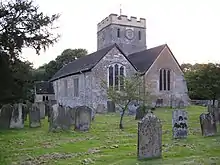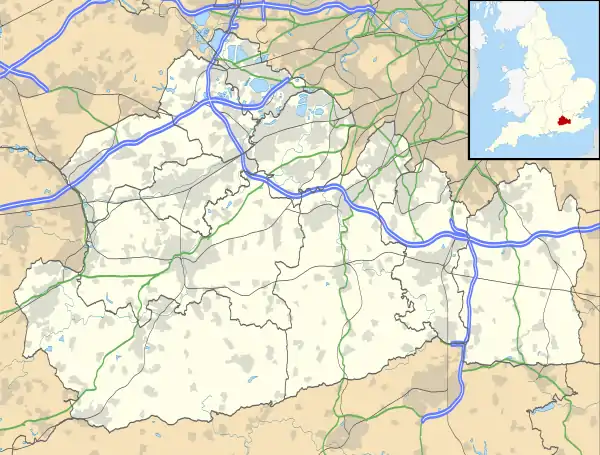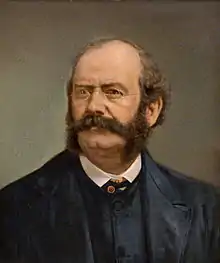Church of St Nicholas, Charlwood
The Church of St Nicholas, Charlwood is the parish church of Charlwood, Surrey, England. With a 12th-century tower and nave section and examples of 13th to 15th century art, fixtures and architecture, it is a Grade I listed building.
| Church of St Nicholas, Charlwood | |
|---|---|
 St Nicholas, Charlwood | |
 Church of St Nicholas, Charlwood Location in Surrey | |
| 51°09′21″N 0°13′39″W | |
| Location | The Street, Charlwood, Surrey, RH6 0EE |
| Country | England |
| Denomination | Church of England |
| Website | St Nicholas Church |
| History | |
| Status | Grade I listed |
| Architecture | |
| Architect(s) | William Burges |
| Style | Norman |
| Years built | 11th to 15th centuries |
| Administration | |
| Parish | Charlwood |
| Diocese | Diocese of Southwark |
| Clergy | |
| Bishop(s) | Rt. Rev. Jonathan Clark (area) Rt. Rev. Christopher Chessun (diocese) |
| Rector | Rev. Sue Weakley |
| Dean | Rev. Andrew Cunnington |
| Archdeacon | Venerable Daniel Kajumba |
Building and its setting
St Nicholas's smallest nave and the tower were built c.1100 with 15th century later medieval building forming most of the remainder. Its parts were restored to surveys and specifications by architect William Burges from 1857 to 1867. The church is a Grade I listed building.[1]
Around 1080 the building of Charlwood church was started. The original church was a simple three-cell structure consisting of a nave, a squat tower without a crossing and a rounded apse beyond.[2]
The Norman church was "enlarged out of all recognition"[3] in the fifteenth century, by the addition of the chancel and doubling of the nave. Burges was commissioned to undertake restoration in 1858, although work did not begin until 1864 and continued until 1867.[4] During restoration, a series of 13th century wall paintings were uncovered and Burges undertook their cataloguing and refurbishment.[5] Its path in the form of a 'stone causeway' and the lychgate along this are separately listed.[6] Many interior features are intricately carved and old furnishings are featured: its octagonal pulpit is one of 1620 and the font is Victorian. In the west window of the former nave are some fragments of ancient glass, a portion of the figure of a saint, and several other odd pieces, including two words of an inscription. Also in the first window of the north wall are two small eyelets containing roses and leaves. Patron Richard Sander (who died in 1480) has his initials, winged dragons and his coat of arms of Sander liberally applied to the interior with examples of 14th and 15th century art and carving.
The baptism, marriage and death registers date from 1595.
The church has a vestry for choir and clergy. The church has its graveyard adjoining to almost all sides and is by a wide track by the largest pub of the village to the return of the bend in its road. The land to the north, within the bend, is the Old Rectory, with two ponds, one of which is known as the rectory pond, a small publicly used fish pond. The current Rector lives in Horley and the Old Rectory is now let
A 25 point/paragraph survey of architectural features and furnishings with plan was written in the Victoria County History in 1911.[7]
Parish
Charlwood is a parish of the Church of England which overlaps its civil parish. This area's nearest town is Horley. The area has two main clusters on radiating rural roads (the second known narrowly as Lowfield Heath) making it somewhat polyfocal but most of the amenities, save for the largest hotel, are in Charlwood itself. The church is 0.5 miles (0.80 km) from most homes. Due to an almost encircling bend it is south, east and west of the low-rise built-up road which has many of the oldest homes facing this 'rectory and church' section.
Parish history
The right to appoint the vicar belonged with the manor to the Prior and Convent of Christ Church, Canterbury Cathedral from at least 1231 to 1527. A vicarage instead of a rectory was ordained by the monks before 1308–9 who would thereafter fund that position in exchange for direct receipt of all the rectorial land and the greater and lesser tithes of the rest of the parish. After the loss of Christchurch under Henry VIII's reforms, the rectory resumed and the right to name the rector transferred to Sir Robert Southwell with the manor, as in 1547 he transferred both to Henry Lechford, whose son Sir Richard conveyed the right to Richard Dallender in 1609. In 1615 Dallender quitclaimed to Robert Hatton, from whom in 1622 it returned to the Lechfords. Sir Richard Lechford, when he sold the manor of Charlwood in 1625, retained the right, selling it, however, in 1629 to Edmund Sander of Charlwood Place, by then a far taller, more grandiose manor in the parish.[7]
In 1644 the Bishop was compelled to sequester the priest position to a new rector, the previous incumbent, Thomas Mulcaster, having been proceeded against by 'five or six of the very scum of the parish,' according to his own account. This was during one of the most visible phases of the European wars of religion in England, the Civil War.[7]
His son-in-law, Henry Hesketh, chaplain in ordinary to Charles II, was afterwards rector of Charlwood. In 1661 Edmund Sander devised all his lands and tenements here including the property of the rectory, to his sister Elizabeth Bradshaw, from whom they passed to her cousin Sir William Throckmorton, who sold in 1672 to Sir Andrew King. In 1716 the rectory and its appointment right were conveyed to Henry Wise from according to Owen Manning the trustees of Francis Aungier, 1st Earl of Longford the intermediate owner. The property remained with the Wises until 1884, during which time the church was often served by members of that family and passed to the Rev. E. M. Gibson and some time after him it vested in the diocese.[7]
- Extraterritorial diocese
In terms of its relevant see of a bishop, Charlwood was 'a peculiar of Canterbury' until 1846, when it was transferred to Winchester. By the rearrangement of dioceses in 1878 it was again transferred to Rochester and was added to Southwark on its creation.[7]
Clergy and style of worship
Part of the Diocese of Southwark, the style of worship is modern high church, with the emphasis on music, modern hymns and language ahead of ritual. The rector equally serves the smaller parish of Emmanuel, Sidlow Bridge, as one benefice.[2]
Regular weekly services are held and the following activities:
- Pre-School Praise: worship, craft, music and refreshments monthly for young children and their carers.
- NicsMix: monthly activities, music and learning for children.
- Venture Week: An annual week of activities, held during the first week of August, for children up to 14 years.
- Mothers' Union: monthly
- Bellringers – The practice night is weekly 7.30 - 9pm
Notes
- Historic England. "Details from listed building database (1248610)". National Heritage List for England. Retrieved 15 March 2012.
- "Charlwood, St Nicholas in the Upper Mole Group of Churches". Upper Mole Group of Churches. Retrieved 5 January 2014.
- Cherry, Nairn & Pevsner, p. 141
- Crook 1981a
- Crook 1981a, p. 226
- Stone path Historic England. "Details from listed building database (1248622)". National Heritage List for England. Retrieved 5 January 2014.
Lychgate Historic England. "Details from listed building database (1277824)". National Heritage List for England. Retrieved 5 January 2014. - H.E. Malden (editor) (1911). "Parishes: Charlwood". A History of the County of Surrey: Volume 3. Institute of Historical Research. Retrieved 5 January 2014.CS1 maint: extra text: authors list (link)
References
- Crook, J. Mordaunt (1981a). William Burges and the High Victorian Dream. John Murray. ISBN 978-0-7195-3822-3.CS1 maint: ref=harv (link)
- Cherry, Bridget; Nairn, Ian; Nikolaus, Pevsner (1971). The Buildings Of England: Surrey. Penguin. ISBN 978-0-14-071021-2.

